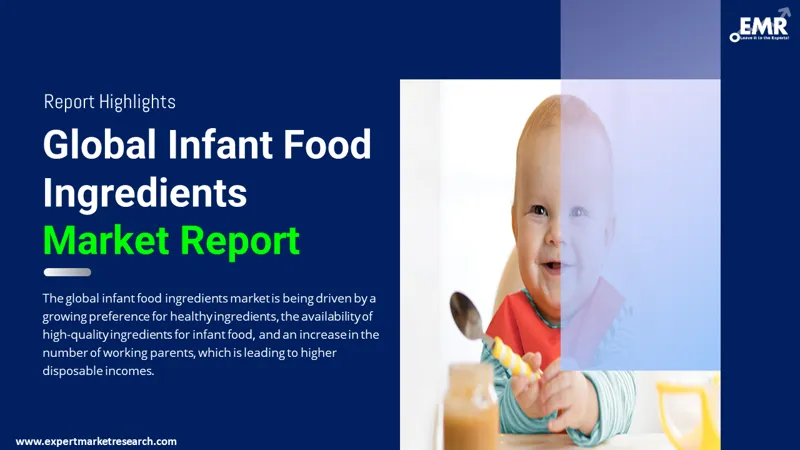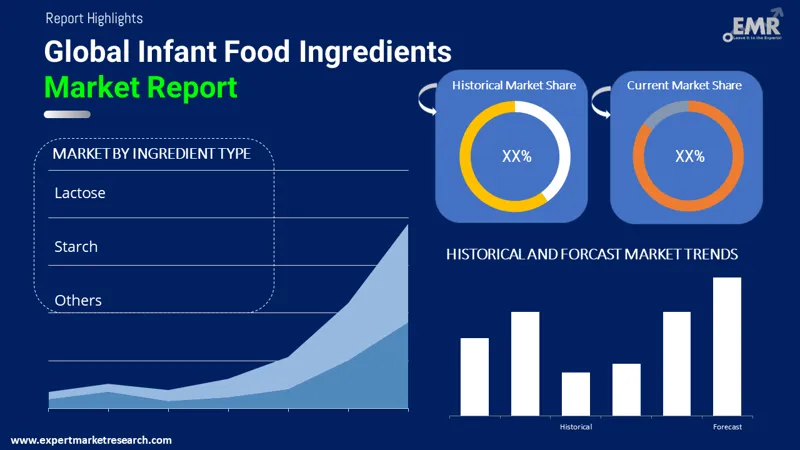
Consumer Insights
Uncover trends and behaviors shaping consumer choices today
Procurement Insights
Optimize your sourcing strategy with key market data
Industry Stats
Stay ahead with the latest trends and market analysis.
The global infant food ingredients market is anticipated to develop at a CAGR of 5.70% during 2026-2035. Infant and toddler foods are generally children’s first solid foods, and expected to offer necessary nutrition during the first two years of life.
Base Year
Historical Period
Forecast Period
Compound Annual Growth Rate
5.7%
2026-2035
*this image is indicative*
Parents’ desire for high-quality food products for their infants and toddlers is likely to boost growth of market. Asia, Europe and North America are likely to be key markets.

Read more about this report - REQUEST FREE SAMPLE COPY IN PDF
In 2018, Lactalis Ingredients announced the opening of a new modern plant dedicated to infant nutrition. Located in France, the new plant was capable of providing different dairy ingredients from WPC 35 to WPC 80 and lactose, all adhering to infant formula requirements. Such developments are anticipated to boost the global infant food ingredients market.
In 2023, Arla Foods launched Lacprodan IF-7390 Organic (protein concentrate produced from organic whey), and Premium Lactose Organic – intended to meet the needs of early life nutrition - along with a variety of organic food concepts. A significant percentage of parents find it very important for a product to be organic before feeding their children; therefore, manufacturers seek to employ high-quality ingredients to gain consumer trust and expand market share. It is expected that organic formula products would witness greater growth during the forecast period.
In 2023, Arla Foods Ingredients received positive EFSA opinion for Peptigen® IF-3080; the product was deemed safe to employ in infant formulas in the European Union.
In 2023, Arla Foods Ingredients introduced its milk fractionation technology to infant formula producers, providing multiple benefits in the manufacture of organic products including an unrestrained supply based on high quality milk.
Cargill manufactures several products to improve processing, stability during storage and consistency in applications pertaining to dried baby food. Ingredients include maltodextrins, lecithin, specialty starches, hydrocolloids and functional systems.
The infant milk formula domain is pushed by innovations that help fulfil new-borns’ nutritional requirements. Particular elements like goat milk, alpha lactalbumine, Lactoferrin, organic dairy ingredients, and milk fat are some novel ingredients that are being considered that offer nutritional benefits and enable diversification and added value to infant milk formulas. Thus, innovations in the domain are likely to drive the global infant food ingredients market.
Organic products are driving market growth, with increasing number of products claiming organic. For example, demand for organic whey and lactose is expected to increase significantly. However, increasing demand for organic raw material and the resultant shortage of supply may impede market growth.

Read more about this report - REQUEST FREE SAMPLE COPY IN PDF
The EMR’s report titled “Infant Food Ingredients Market Report and Forecast 2026-2035" offers a detailed analysis of the market based on the following segments:
By ingredient type, the market is segmented into:
On the basis of region, the market is divided into:
The report offers a comprehensive assessment of key players in the global infant food ingredients market, evaluating their capacity, and monitoring latest developments like plant turnarounds, capacity expansions, and mergers and acquisitions; key players in the domain include:
The EMR report gives an in-depth insight into the industry by providing a SWOT analysis as well as an analysis of Porter’s Five Forces model.




*While we strive to always give you current and accurate information, the numbers depicted on the website are indicative and may differ from the actual numbers in the main report. At Expert Market Research, we aim to bring you the latest insights and trends in the market. Using our analyses and forecasts, stakeholders can understand the market dynamics, navigate challenges, and capitalize on opportunities to make data-driven strategic decisions.*
Get in touch with us for a customized solution tailored to your unique requirements and save upto 35%!
The market is estimated to grow at a CAGR of 5.70% between 2026 and 2035.
The major regions in the industry are North America, Latin America, the Middle East and Africa, Europe, and the Asia Pacific.
Increasing inclination towards healthy ingredients, easy accessibility to top-quality infant food ingredients, and increasing number of working parents leading to heightening disposable income are some of the key factors influencing the global infant food ingredients market.
The major drivers of the market include the increasing birth rate across emerging economies, increasing awareness pertaining to healthy infant food ingredients, and increasing popularity of homemade infant food recipes.
The growing expansion of the e-commerce sector, rising purchasing power of parents, and increasing advertising of infant food ingredients on social media platforms are some of the key trends in the market.
Lactose, edible oil, maltodextrins, whey protein concentrates, sucrose, and starch are the different segments based on ingredient type.
The major players in the industry are Arla Foods amba, Lactalis Ingredients, Fonterra Co-operative Group Limited, Koninklijke DSM N.V, and Glanbia Plc, among others.
Explore our key highlights of the report and gain a concise overview of key findings, trends, and actionable insights that will empower your strategic decisions.
| REPORT FEATURES | DETAILS |
| Base Year | 2025 |
| Historical Period | 2019-2025 |
| Forecast Period | 2026-2035 |
| Scope of the Report |
Historical and Forecast Trends, Industry Drivers and Constraints, Historical and Forecast Market Analysis by Segment:
|
| Breakup by Ingredient Type |
|
| Breakup by Region |
|
| Market Dynamics |
|
| Competitive Landscape |
|
| Companies Covered |
|
Single User License
One User
USD 3,999
USD 3,599
tax inclusive*
Datasheet
One User
USD 2,499
USD 2,249
tax inclusive*
Five User License
Five User
USD 4,999
USD 4,249
tax inclusive*
Corporate License
Unlimited Users
USD 5,999
USD 5,099
tax inclusive*
*Please note that the prices mentioned below are starting prices for each bundle type. Kindly contact our team for further details.*
Flash Bundle
Small Business Bundle
Growth Bundle
Enterprise Bundle
*Please note that the prices mentioned below are starting prices for each bundle type. Kindly contact our team for further details.*
Flash Bundle
Number of Reports: 3
20%
tax inclusive*
Small Business Bundle
Number of Reports: 5
25%
tax inclusive*
Growth Bundle
Number of Reports: 8
30%
tax inclusive*
Enterprise Bundle
Number of Reports: 10
35%
tax inclusive*
How To Order

Select License Type
Choose the right license for your needs and access rights.

Click on ‘Buy Now’
Add the report to your cart with one click and proceed to register.

Select Mode of Payment
Choose a payment option for a secure checkout. You will be redirected accordingly.
Gain insights to stay ahead and seize opportunities.

Get insights & trends for a competitive edge.

Track prices with detailed trend reports.

Analyse trade data for supply chain insights.

Leverage cost reports for smart savings

Enhance supply chain with partnerships.

Connect For More Information
Our expert team of analysts will offer full support and resolve any queries regarding the report, before and after the purchase.
Our expert team of analysts will offer full support and resolve any queries regarding the report, before and after the purchase.
We employ meticulous research methods, blending advanced analytics and expert insights to deliver accurate, actionable industry intelligence, staying ahead of competitors.
Our skilled analysts offer unparalleled competitive advantage with detailed insights on current and emerging markets, ensuring your strategic edge.
We offer an in-depth yet simplified presentation of industry insights and analysis to meet your specific requirements effectively.
Share